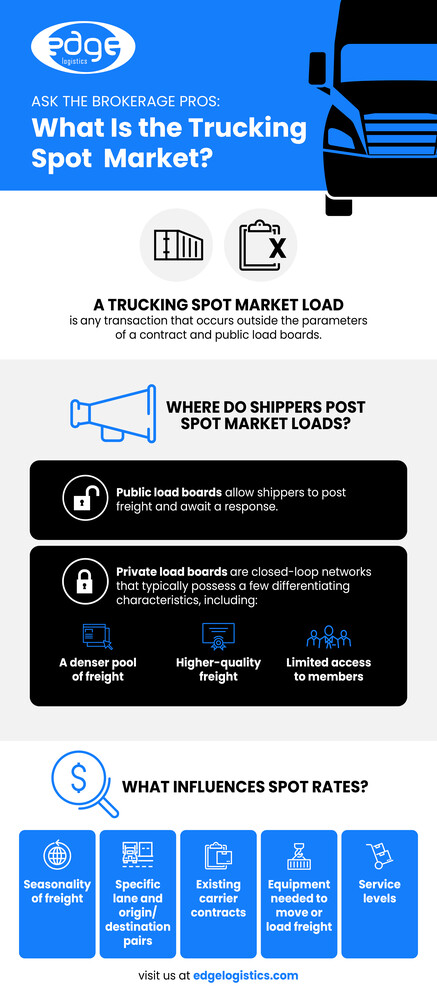Ask the Brokerage Pros: What Is the Trucking Spot Market?
.jpg) Pamela Nebiu
August 31, 2021
Pamela Nebiu
August 31, 2021

Understanding the trucking spot market can be complicated. Let’s review its fundamentals today.
The spot market can be a bit of a misnomer. All freight is bought and paid for on spot. However, freight can move through contracted carriers and trucks or spot carriers and trucks. A true trucking spot market load is any transactional move that occurs outside the parameters of a contract. Spot market loads might be necessary to accommodate overflow, increased demand from customers for peak season, and more. Most often, the trucking spot market is accessed by directly contacting a carrier or trucker and presenting the load as available, otherwise known as tendering the load.
Where Do Shippers Post Spot Market Loads
Posting or tendering a load simply means putting it out there for available carriers to bid on and potentially accept. It is possible to tender the load directly as a one-off quote or through the available load boards.
For example, the public load board, DAT, allows shippers to post freight and await a response. Meanwhile, private load boards are closed-loop networks that typically possess a few differentiating characteristics, including:
- A denser pool of freight
- Higher-quality freight
- Limited access to members
What Influences Spot Rates
It all comes down to market volatility. Supply and demand between capacity and loads is the most universal factor. However, additional influences exist within:
- The seasonality of the freight
- Specific lanes and origin/destination pairs
- Existing contracts with the carriers when requesting a direct quote for a spot load
- The equipment needed to move or load the freight
- Service levels
If the carrier or trucker accepts a load in the trucking spot market, it initiates a one-off contract between the shipper and transportation provider. However, the carrier may reject the load, and over time, added rejections amount to the need to offer a higher rate to carriers. This is simply presenting a willingness to pay more in the hope that a carrier accepts the load.
A prime example of this activity has been ongoing since the start of the pandemic. As e-commerce volumes grew, shippers needed to move more freight. And with a greater ability to be selective when choosing whether to accept or reject a load, carriers have gained the upper hand.
In other words, they can ask for higher and higher rates to justify their moves. In other cases, a load might not necessarily be unappealing, but it comes with the risk of an empty backhaul. That means the carrier must look at the return trip cost of running empty, which is yet another influencer of spot rates.
Empty miles mean lost money. Therefore, shippers have had to get creative, thinking about consolidation opportunities and expanding their carrier networks to take advantage of carriers’ demands for fewer empty miles. This is where working with a freight brokerage can add the most value.
Choose the Right Freight Brokerage to Navigate the Trucking Spot Market
In today’s world of logistics, timeliness is everything. Timeliness also comes from working with industry insiders, like those at Edge Logistics, that can leverage the latest market research tools to ensure spot rates in one market are accurate. And by knowing more about the market, shippers can find coverage for their spot freight more easily. Of course, that’s an entirely different animal, and we will discuss how a brokerage improves spot market freight spend in part two of this infographic series. In the interim contact Edge Logistics to find out more about how a brokerage can help your company excel in all aspects of transportation procurement.
About the Author
.jpg)
Pamela Nebiu
Pamela is the Senior Marketing Manager at Edge Logistics. She has a Bachelors of Arts from DePaul University in Public Relations and Advertising with a minor in Photography. Pamela is responsible for overseeing advertising, marketing, press, and social media related to Edge.

